THAILAND
Economy

Economy

Cities in THAILAND
| Bangkok |
Economy
General
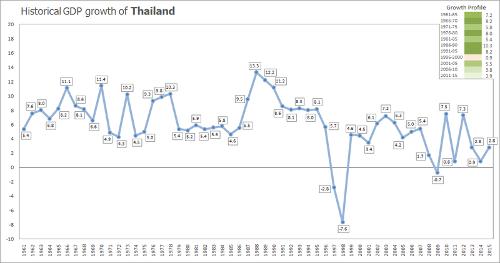 Overview economic growth ThailandPhoto: GiovanniMartin16 CC 4.0 International no changes made
Overview economic growth ThailandPhoto: GiovanniMartin16 CC 4.0 International no changes made
Thailand has a free market economy, in which the private sector is the most important. In 2017, 31.8% of the labor force was employed in agriculture and fishing, 16.7% in industry and 51.5% in the service sector. In 2017, the labor force numbered 38.4 million people.
The Thai economy grew by 3.9% in 2017. Growing exports, government spending and consumer spending are at the root of economic growth. Thai exports rose in 2017, especially exports to ASEAN countries and China increased strongly.
Increased consumer spending and strong economic growth the labor market a revival. The percentage of unemployed was 0.7% in 2017. Unemployment is highest in North and Northeast Thailand and lowest in and around the capital Bangkok.
Despite the fact that almost a third of the working population is dependent on agriculture and fishing and the majority of exports are made up of agricultural products, the relative share of the agricultural sector in the composition of the Gross National Product (GNP) has decreased from 30% in 1970 to 8 , 2% in 2017 (services 55.6%; industry 36.2%).
The government's economic policy is aimed at increasing economic growth by stimulating domestic demand, aimed at to become less dependent on external influences. This will not be easy for a country that has always depended heavily on exports and foreign investment. They try to boost domestic consumption with a lot of government money. And other goals are rural development and improving the living standards of the poor part of the population.
Important for the economy is the Association of South East Asian Nations (ASEAN), founded on January 1, 1993. The original members were Thailand, Indonesia, Singapore, Malaysia, Philippines and Brunei. The objective was to create an open market of approximately 450 million consumers.The later acceded Member States Vietnam, Laos, Cambodia make the internal market even bigger
Agriculture, livestock, forestry and fishing
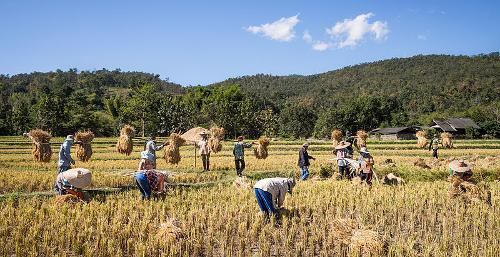 Rice farming, ThailandPhoto: Takeaway CC 4.0 International no changes made
Rice farming, ThailandPhoto: Takeaway CC 4.0 International no changes made
The agricultural sector, including fishing, plays an important role in the Thai economy despite the strong rise of the industry. Agricultural exports (including fish and forest products) make up a large part of Thailand's total exports.
Rice farming (especially jasmine rice) India and Vietnam are the main rice exporters in the world. especially cassava (tapioca), of which the EU, in particular Netherlands, purchases approx. 90% in the form of animal feed. Thailand is also the largest orchid producer in the world and, after Hawaii, the largest producer of pineapples in the world.
Livestock farming is becoming increasingly important to the Thai economy, in particular the dairy industry and poultry and pig farming. The poultry sector is the most important and Thailand is the fourth largest exporter of chicken and chicken meat in the world. The avian flu in January 2004 caused an import stop by the main consumer countries. Total fresh milk production amounted to approximately 760,000 tonnes in 2003. Fisheries are important for protein supplements to the daily rice consumption and are carried out both on inland waters and at sea. Much fish is also intended for export, and shrimp farming is particularly important (50% goes to the United States; almost 400,000 employees), in addition to the export of lobster, tuna and squid. After China and Japan, Thailand is the most important fishing country for Asia.
In 1981, more than 53% of the country was covered with forest, in 2003 this percentage was reduced to over 20% due to excessive logging. Thailand has therefore not been an important wood producer for several decades. The government is trying to expand the forest area to 40% of the total land area. However, illegal logging and smuggling to neighboring countries is a major problem. The south supplies yangwood; the teak forest in the north has almost completely disappeared due to the disastrous deforestation, as a result of which Thailand has started importing teak from Burma and Laos. In 1989 the commercial logging and export of teak wood was banned. Isolated patches of teak forest can still be seen in their natural environment or in large new plantations. Teak trees can be recognized by their enormous size, they can reach more than 100 meters in height, and by their large, limp leaves. Thailand is one of the world's leading importers of tropical lumber.
Energy supply
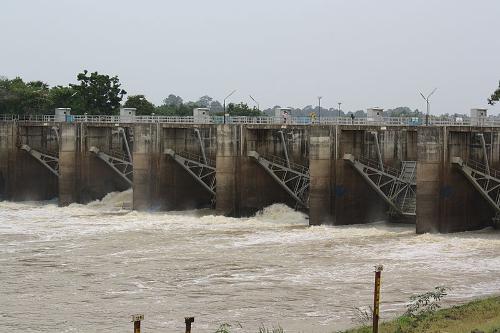 Rasisalai dam, ThailandPhoto: Pongsak ksm CC 3.0 Unported no changes made
Rasisalai dam, ThailandPhoto: Pongsak ksm CC 3.0 Unported no changes made
The energy in the form of electricity is mainly supplied by natural gas, in addition to hydropower, lignite and petroleum. Approx. two-thirds of the total energy supply is provided by oil, of which the largest part must be imported. The government wants to drastically limit the import of oil by implementing energy-saving projects and increasing use of its own gas reserves. Demand for natural gas has therefore increased sharply in recent years; approx. 40% of the total energy demand is covered by natural gas. Almost three-quarters of the natural gas produced is used to generate energy.
The Thai government will stimulate the generation of electricity from solar, wind and renewable energy, but alternative energy sources currently hardly cover & eacute; & eacute; one percent of Thailand's energy requirement. Along the northern border with Myanmar, a very large solar-powered power plant was commissioned in 2004.
Over 60% of energy is consumed by industry and services; energy consumption in homes amounts to about 22%.
Mining
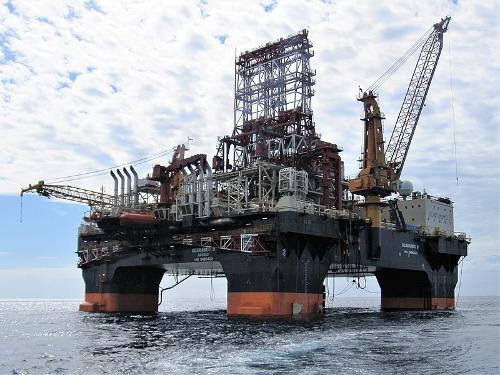 Thailand oil exploitationPhoto: Vidar Lokken CC 3.0 Unported no changes made
Thailand oil exploitationPhoto: Vidar Lokken CC 3.0 Unported no changes made
Mining contributes approximately 2.1% to the national income. In addition to oil and gas, Thailand also has large reserves of zinc and lignite. There are also exploitable stocks of gold, silver, copper, tungsten, manganese, antimony and lead.
Tin is a very important mineral resource for the economy, but since the tin crisis in 1985, increasing export earnings have exceeded of precious stones (sapphire, ruby, garnet, quartz) that of tin.
Large oil fields have been discovered in the Gulf of Thailand. Oil reserves were estimated at 516 million barrels at the end of 2002. Thailand has four refineries with a total capacity of approximately 700,000 barrels per day.
Natural gas reserves are estimated at 12.7 trillion cubic feet. Most of the natural gas is used to generate electricity.
Gold is present in almost all provinces of Thailand. The gold reserves are estimated at 32 tons and the silver reserves at 98 tons. The quantities of copper are estimated at 900 tons and in Thailand also sapphires, beryl, jade et al, rubies, zircon and garnet. The gemstones are used to make gold and silver jewelry and decorations.
Industry
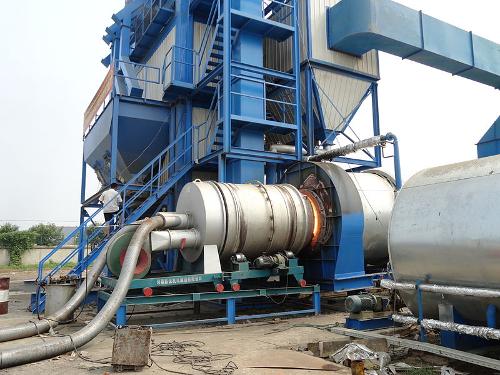 Industry ThailandPhoto: Wikisay CC 3.0 Unported no changes made
Industry ThailandPhoto: Wikisay CC 3.0 Unported no changes made
GENERAL
Thailand has practically no heavy industry, but the small industry has grown very strongly in recent decades. Main branches are the textile and food industry and other industries are car assembly, cement and electronics industry, construction, sugar and oil refinery. Government policy is aimed at stimulating industries that largely replace imports.
CONSTRUCTION
Important for Thai economy. Mainly private housing, but also offices and hotels. Architects, suppliers of building materials and manufacturers of home products and accessories for the decoration of homes and commercial buildings will also benefit.
CHEMISTRY AND PLASTICS
Thailand is Southeast Asia's largest paint producer, with approx. 300,000 tons per year.
The petrochemical industry is an important supplier for the production of plastic products, electronics and automotive parts. Raw materials and machines for this sector are mainly imported from Japan and the United States.
Approximately 5,000, mainly small companies, are active in the plastics industry. Approximately 30% of the total production is exported mainly to Japan, the United States, Hong Kong, Singapore, Australia, Malaysia, China and the European Union.
ELECTRONICS
The electronics industry is one of the main pillars of the Thai economy, with many foreign investors from Japan and the United States.
In 2003, about 33 million hard disk drives have been exported and Thailand thus has a worldwide share of almost 18%.
Trade
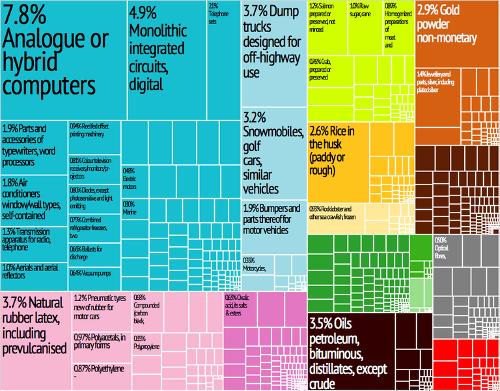 Export ThailandPhoto: R. Haussmann Cesar Hidalgo,et.al. CC 3.0 no changes made
Export ThailandPhoto: R. Haussmann Cesar Hidalgo,et.al. CC 3.0 no changes made
Until the crisis year of 1997, the Thai trade balance was characterized by a continuous deficit, despite the strong increase in exports. The trade surplus already rose to 1.6 billion dollars during the crisis year, and a trade surplus was also reached in subsequent years. In 2017, Thailand had a trade surplus of $ 32 billion. Thailand's total exports amounted to $ 235 billion in 2017.
The industrial sector is the main driver of Thai exports. Main exports are machinery, electrical appliances, computer and computer parts, rice, corn, tapioca, rubber, tin metal, textile products and food (Thailand is the world's largest exporter of canned tuna and pineapple). Main customers are: China (including Hong Kong), Japan, Malaysia, Singapore, Austrarlia and the United States.
Thailand's total imports in 2017 were $ 203 billion, nearly half of which were capital goods. Due to the shift from agriculture to industry, Thailand has become heavily dependent on the import of raw materials, semi-finished products and capital goods. Mainly imported: raw materials, machines, petroleum and chemical products. Main suppliers are: Japan, United States, United Arab Emirates, Singapore and China (including Hong Kong).
Traffic
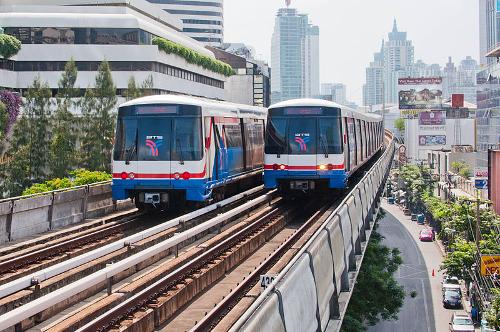 Skytrain Bangkok, ThailandPhoto: My Train Pix CC 2.0 no changes made
Skytrain Bangkok, ThailandPhoto: My Train Pix CC 2.0 no changes made
In the 1970s, the road network expanded at an accelerated pace for economic and strategic reasons, but is now no longer sufficient at 80,000 km, as only 40,000 km is of good quality. To promote trade between India, Myanmar and Thailand, a 1400-kilometer highway has been constructed. A major problem is the increasing traffic chaos in Bangkok. An important urban transport plan has been developed to relieve road transport in Bangkok. Construction of the first 20 kilometers of a metro line has been completed and could be connected to an already operational skytrain above ground.
Road and rail links between Chiang Mai, Bangkok and the rest of Thailand are excellent. The State Railway of Thailand maintains the nearly 4,500 km long rail network, with only 100 km double track. The government provides for the construction of new railway lines and expansion of the double track. The main lines run from Bangkok to the north to Myanmar, to the northeast to Laos and Cambodia and to the south to Malaysia & euml; and Singapore. Of historical and today tourist interest is the legendary Burma Railway.
Thailand's main seaport is Bangkok's Klong Toey. Here approximately 90% of all sea freight is handled. Due to congestion problems in Klong Toey, a container port in Laem Chabang and an industrial port in Ma Ta Phut were constructed. Other important ports in the country are Songkhla and Phuket in the south of the country. Pattaya is an important port for cruise ships along the Gulf of Thailand and the southeast of the country. A canal will be built from the Indian Ocean to the Gulf of Thailand, probably in collaboration with China and Japan.
The national airline is Thai Airways International (TAI). Don Muang International Airport near Bangkok is the main international airport; more than eighty airlines fly here and more than 30 million passengers are processed every year. Southeast of the capital, construction began in late 2001 on a second international airport, Suvarnabhumi International Airport, with the largest terminal in the world. Other international airports are Chiang Mai to the north, Phuket and Hat Yai to the south.
Sources
Clutterbuck, M. / Thailand
Van Reemst
Davies, B. / Thailand
Kosmos-Z&K3
Forbes, A. / Thailand
Kosmos-Z&K
Hahn, W. / Thailand
Van Reemst
Hauser, S. / Thailand : mensen, politiek, economie, cultuur, milieu
Koninklijk Instituut voor de Tropen
Hoskin, J. / Thailand
Van Reemst
Macdonald, P. / Thailand
Kosmos-Z&K
Miethig, M. / Thailand
Lannoo
Peterse, L. / Thailand
Gottmer/Becht
Steinmetz, P. / Thailand
Elmar
Thailand
Uitgeversmaatschappij The Reader’s Digest
Thailand
Lannoo
CIA - World Factbook
BBC - Country Profiles
Copyright: Team The World of Info